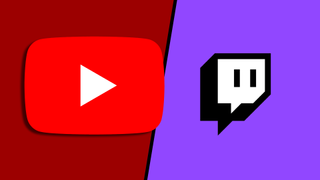YouTube needs to get serious about small streamers if it wants to rival Twitch
What does YouTube need to do to catch up with Twitch as a live streaming platform?

Twitch and YouTube are livestreaming's biggest players right now. Mixer went under and Facebook Gaming is, um, Facebook Gaming, so these are the places to be if you're hoping to stream to an audience of tens of thousands. Though YouTube has done well to hold its own against the more established streaming platform by snapping up some of the world's biggest streamers, it's not quite found its footing among smaller streamers. Even TikTok is getting to be better known for livestreams than YouTube. It should have many advantages by serving as a two-in-one platform for live and pre-recorded video, but it hasn't yet beaten Amazon. So what does YouTube need to do to catch up to Twitch?
Well the key is in its community, or lack thereof. Twitch was the first streaming platform of note, starting out in 2007 as Justin.tv, and naturally has the upper hand as the OG—but it's not been successful when it comes to building a community just because it's been around for a long time.
Twitch's trick to fostering its community is its raid and hosting systems. When streamers finally find an audience, it's rare for it to be an audience that they serve alone. No matter how small or large, if someone watches streamer X there is a large chance they are also going to support their friend streamer Y. X and Y might even stream together on occasion. When they're not streaming together and X goes offline before Y, they may raid or host Y, sending their viewers over to say hello, conscious of the overlap.

This is the ebb and flow Twitch provides that YouTube has only really just started to foster. YouTube calls its raid system Live Redirect, but you have to be a partner to raid other channels, though anyone can be raided if they're subscribed to the person raiding. And then you have to make sure you're subscribed to the person on YouTube already, and then there are some other settings to check out to make sure it's working, according to this one help guide. It's convoluted and difficult compared to Twitch's alternative and, though Twitch suffered a long period of hate raids (and while they still occasionally happen), no one ever wanted raids to go away, signifying just how important they are to Twitch's culture.
Hosting a raid from a channel you're not familiar with can feel like an honour on Twitch. It's new people, new faces seeing your content. It's like buying a drink for a friendly stranger in a bar you've just got talking to. You feel connected and sometimes it starts a whole new friendship. And if the community size difference is big enough it can change a lot for the smaller streamer—potentially opening the door to a much larger audience.
YouTube's own multiple functions are also working against its success. When I typed "YouTube streaming" into Google, the search engine assumed I was talking about streaming content like films, not livestreams. So YouTube has regular videos, movies and shows, and then also live streaming, and navigating between each is incoherent and messy. And that's saying something when Twitch's UI can be famously unhelpful for smaller streamers already by pushing them to the bottom of the pile.

When I pressed the Live tab on my company Google account the content pushed to me included Steven Crowder, golf tournaments, and a baffling amalgamation of sketches for kids titled "IF OBJECTS WERE PEOPLE, Food and Makeup Are Alive! Crazy Relatable Situations". There is nothing about this page that suggests to a new streamer that this is the place for them, especially not when Twitch is right around the corner showing a far more relatable page of streams—the type of things they might think they could make themselves.
The biggest gaming news, reviews and hardware deals
Keep up to date with the most important stories and the best deals, as picked by the PC Gamer team.
YouTube has made strides to bolster its roster of streamers, however. Every month or so a new streamer announces they're moving to YouTube. But YouTube's deals with these bigger streamers have very little effect on the smaller streaming community. You can have Myth, LilyPichu, Ludwig, TimTheTatman, and more on your platform, but what seems to have happened is that fans are going to YouTube for those streams and those streams alone. They're not going because the streaming community is thriving or even a solid community at all. They're coming to YouTube Live to watch streamers they've already fallen in love with elsewhere.
The exception to the rule is Valkyrae, whose popularity boomed not on Twitch but YouTube. She was a big streamer before but really found her stride while on Google's platform. That has arguably less to do with streaming and more to do with the Among Us boom, and the YouTube videos and clips that spun out of those play sessions. And importantly, streamers were collaborating across Twitch and YouTube at that point, so her voice and presence was still felt on Twitch in the lobbies of other streamers, straddling the streaming spheres.

YouTube's streaming space is more like the European Union, while Twitch is more like the USA. YouTube streamers are like countries with an overarching governing body, and these countries are distinctly separate from one another. Twitch streamers are more like states, blending more seamlessly without borders though there are still individual communities present. On YouTube, the communities care more about their individual countries than the governing body, but on Twitch there is a far stronger sense of love for the platform and its power overall. Even if they have gripes with the shitty things it does every so often.
When I interviewed streamers about the State of Twitch earlier this year, every single one said they're do it all again on Twitch despite the success they've seen some have on YouTube. That's of course a biased group as they stream on Twitch, but even as a streamer myself, I can't imagine starting again on YouTube—not right now at least. When I started streaming a little over two years ago, and was thinking about where to stream, Twitch seemed like the only sensible option. Mixer was small, YouTube was a video platform with the Live after thought, Facebook seemed toxic, and Twitch was, well, Twitch. The livestreaming platform. Even with YouTube's better streaming quality, potentially better ad revenue, and multiple functions, it was Twitch that captured my attention, like so many others in lockdown.

YouTube's streaming platform feels like it's still under construction. It needs to find a way to bring more than just the biggest names in streaming over. Maybe there are people there dedicated to improving the lower end of the streamer scale, but we're yet to see significant results. Though it holds so much power over the growth of Twitch streamers as a video hosting website, where streamers place VODs and highlights, it's still struggling to rival Twitch's title as the home of live streaming or even gaming.
What YouTube needs to do is find a way to make streaming on YouTube feel like a home rather than an alternative. It needs to make streamers feel welcomed and a central part of what YouTube does, rather than a 'Live' afterthought next to all other videos the internet has ever seen. Make streamers feel special, like YouTube is the place to be. Otherwise Twitch will always be number one.
Imogen has been playing games for as long as she can remember but finally decided games were her passion when she got her hands on Portal 2. Ever since then she’s bounced between hero shooters, RPGs, and indies looking for her next fixation, searching for great puzzles or a sniper build to master. When she’s not working for PC Gamer, she’s entertaining her community live on Twitch, hosting an event like GDC, or in a field shooting her Olympic recurve bow.
Most Popular


